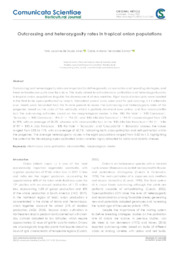Outcrossing and heterozygosity rates in tropical onion populations.
Outcrossing and heterozygosity rates in tropical onion populations.
Author(s): ALVES, I. L. de S.; SANTOS, C. A. F.
Summary: Outcrossing and heterozygosity rates are important to define genetic conservation and breeding strategies, and these estimates are quite rare for onions. This study aimed to estimate cross-pollination and heterozygosity rates in tropical onion populations to guide the development of new varieties. Eight tropical onion pairs were isolated in the field to be open-pollinated by insects. Vernalized parent bulbs were used for pair-crossing in 1:1 alternate rows. Seeds were harvested from the female parents to assess the outcrossing and heterozygosity rates of the progenies based on the color of the red bulb, which is partially dominant over yellow, and four microsatellite loci. The outcrossing estimates based on the morphological marker in the ?BRS Rio Vale? × ?BRS Carrancas?, ?Botucatu? × ?BRS Carrancas?, ?IPA 11? × ?IPA 10?, and ?BRS Alfa São Francisco? × ?IPA10? crosses ranged from 15% to 39%, with an average of 28.2%, whereas with microsatellite loci, in the ?BRS Alfa São Francisco?×?IPA 11?, ?Alfa SF RT? × ?BRS A. São Francisco?, ?BRS Rio Vale? × ?Botucatu?, and ?Cascuda T6? × ?Botucatu? crosses, the values ranged from 33% to 71%, with an average of 42.7%, indicating both cross-pollination and self-pollination within the progenies. The average heterozygosity values in the eight populations ranged from 0.82 to 1.0, highlighting the potential for developing open-pollinated onion varieties highly adapted to biotic and abiotic stresses.
Publication year: 2022
Types of publication: Journal article
Unit: Embrapa Semi-arid Region
Observation
Some of Embrapa's publications are published as ePub files. To read them, use or download one of the following free software options to your computer or mobile device. Android: Google Play Books; IOS: iBooks; Windows and Linux: Calibre.
Access other publications
Access the Agricultural Research Database (BDPA) to consult Embrapa's full library collection and records.
Visit Embrapa Bookstore to purchase books and other publications sold by Embrapa.

